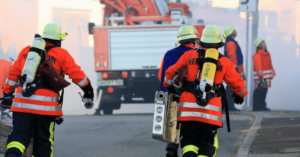When you’re bringing visitors on-site, safety needs to be one of your biggest considerations.
Key Points:
- Within the construction and manufacturing industries there are plenty of dangers to be aware of, especially for those who may not be familiar with your workplace.
- Hazardous substances, moving vehicles, and uneven surfaces present risks that must be reduced as much as possible to make your site a safe place to visit.
- With the construction industry accounting for a quarter of all work-related fatalities in 2021/2022, it’s vital that the right measures are taken to keep visitors, as well as workers, safe on site.

What do businesses need to do legally to avoid accidents?
Legally, businesses have a responsibility to make sure anybody from outside the company isn’t injured or worse, killed, on-site.
Section 3 of the Health and Safety Act 1974 outlines the ‘General duties of employers and self-employed to persons other than their employees.’
It states:
‘It shall be the duty of every employer to conduct his undertaking in such a way as to ensure, so far as is reasonably practicable, that persons not in his employment who may be affected thereby are not thereby exposed to risks to their health or safety.’
As well as protecting the visitors you’re expecting on-site, you also have a responsibility to prevent those who may be trespassing from being harmed, according to the Occupier’s Liability Act, 1984.
Children, vandals, or urban explorers who may be exploring your site for their social media profiles, all need to be protected, despite the fact you did not invite them on to your site.
If this is an issue you’re concerned about, you may be able to take out an injunction to make trespassing on your premises a criminal offence. Otherwise, you’ll be liable if an unexpected visitor injures themselves on-site.

Eight tips on preventing visitor accidents while on-site
You should take all the necessary precautions to make sure visitors are kept safe while they’re on-site, such as:
#1. Sign all visitors in and out.
- A visitor book should be available at the entrance of your site and should be filled out by any non-worker.
- Although this is a piece of admin that some may deem unnecessary, especially if they’ve visited before, a checking-in book can be vital in an emergency to make sure everyone is accounted for.
- Giving your visitors badges so that workers can differentiate them from the rest of the workforce can also be valuable, as they’ll be more aware that visitors won’t be as familiar with the site.
#2. Provide a comprehensive induction
- All visitors should be given an induction when they arrive to make them aware of any hazards on-site and what to do in an emergency. If they’re a returning visitor, they should also be briefed on any changes and developments since their last visit so they’re fully aware of any dangers.
#3. Establish a point of contact
- Your visitors should be given a dedicated point of contact who they can refer to at any time. This can stop visitors from wandering around the site, trying to find someone to talk to if they have any questions.
- Make sure your visitor knows who their main point of contact is, and where they will be found, if they’re not being accompanied at all times.
#4. Install security measures to deter trespassers
- Stepping up your security measures can also help to keep trespassers off your site while you’re not around.
- Anti-climb devices, CCTV, patrols, and ladder guards can all bring tighter security to your site.
#5. Carry out regular risk assessments.
- Risk assessments are essential to understanding the risks that are present in your workplace, and how to eliminate them or minimise them as much as possible.
- Taking visitors into account when you carry out risk assessments can help you to determine what PPE will be required such as hi-vis vests and safety boots, and how you can best inform your visitors about any potential hazards.
#6. Create an authorisation process
- All visitors must be authorised to be on-site by the right person such as a Health & Safety Manager.
- If there is no set process to follow, lots of employees may bring in lots of visitors at the same time, increasing the risk of overcrowding.
- Put a process in place to ensure visitors are authorised to be on-site before arriving.
#7. Mark traffic routes clearly
- Using brightly-coloured tape on the floor to mark traffic routes and any one-way systems is crucial for outlining safe pedestrian routes around the site.
- Putting up signage can also help visitors understand the paths they need to stick to.
#8. Reduce the risk of slips and falls
- Using the correct lighting and making sure floors are well-maintained can also help keep visitors safe while they’re on-site.
Upskill your workforce with outstanding Health & Safety qualifications
Training your team to understand the dangers of bringing visitors on-site is vital.
We’re a NEBOSH Gold Learning Partner which means we’ve been awarded the highest standards of delivery in occupational health and safety.
Take a look at our full list of health and safety qualifications , and chat with our team about tailoring any of our programmes to suit your business.







